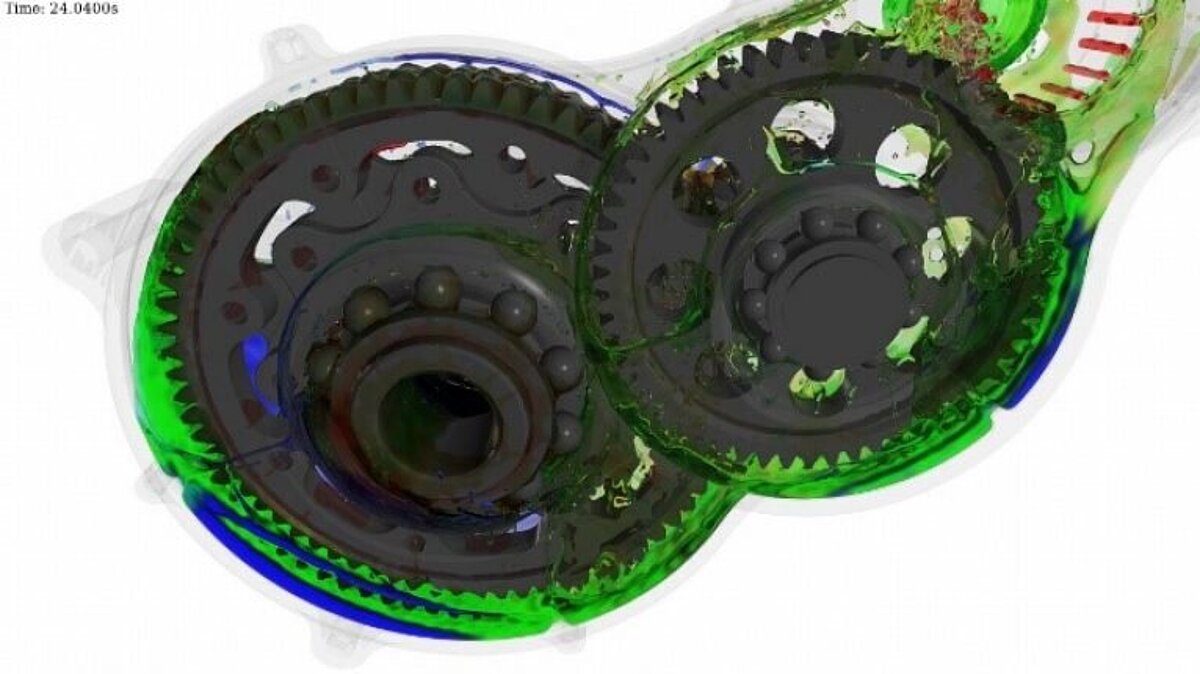Gear lubrication 3.0 - temperature is at the top of our customers' wish list

For more than 10 years now, we have been dealing with the simulation of oil distribution in gearboxes.
In our simulation kit M&P ÖlSim® an essential component was missing until now, which is on top of the wish list of our customers: The consideration of temperature.
Frictional heat is generated in the gearbox and, in addition to lubrication, the oil also has the task of dissipating this heat. The heat also has a significant influence on the viscosity of the oil and thus also on the flow behavior.
I had to learn this painfully during my internship at Dornier in Oberpfaffenhofen in 1983. My old Mercedes 200 D had involuntarily given up the ghost or was forced to be taken out of service by the TÜV. To be more precise, the body was so dilapidated that even the footwells filled with concrete could no longer hold the vehicle together, especially since the TÜV was not at all enthusiastic about this type of repair.
A business colleague at Dornier knew an acquaintance who was selling a Mercedes 220 D, supposedly in very good condition. When I inspected the car in winter, I wondered why the engine was already running, but thought nothing more of it. So I signed the sales contract and drove home with the vehicle. The next winter morning I was surprised that the engine did not start despite the new battery. Unfortunately, I found out that the seller had put in very viscous oil to hide the fact that the compression was at the end. With the viscous oil, the compression was better, but the starter was never, ever able to start the cold engine.
As a student, I had to write off the 4,000 DM I had paid, bought as is, after all, as a budding engineer, I should have noticed that...
And today? Even today, oil is damn tough at -20°C.
From all the discussions we have had with BMW, Audi, VW, Porsche, Daimler and also at ZF, temperature calculation is therefore very high on the wish list.
So essentially, the aim is to optimize the temperature distribution in the components and the cooling of the transmission. The resulting temperature distributions are to be determined on the basis of the power losses in the gear mesh (which one knows) and the cooling on the outside (which one can also determine). And the dependence of the viscosity of the oil? A matter of honor, must be taken into account.
The problem so far has been the enormous computing times and storage space required, although we are not badly positioned in this respect. But who likes to wait a few months.
Christian, who likes to call himself an old fox, has now dug through his drawer and revived an ancient concept from Audi times.
The idea is simple and has already worked well with AURA for calculating the temperature in the vehicle body:
Let's just assume that the gear wheel turns faster than the heat spreads.
Let's further assume that the flow field sets up faster than a quasi-stationary temperature distribution.
Is it not then sufficient to calculate the flow at selected times and keep it constant in between?
In engineering terms, we are also moving on different time scales. The pure flow in the gearbox moves in the millisecond to second range, whereas the temperature is sluggish and moves in the minute to even hour range.
If you now perform a co-simulation with different time scales, this saves a lot of computing time. And memory. And nerves. Says Oli.
Kai recently calculated a large autoclave transiently using a co-simulation in Star CCM+ with top results. So why shouldn't the whole thing work for a gearbox? At least for "smaller" transmissions. For an 8-speed dual-clutch transmission, we still have our doubts, but that's what I'm standing behind with the whip.
We show an intermediate solution in video 1, which we implemented with PreonLab. As always, it is impossible to show customer projects that don't already have 10 years under their belt, so Oli has "raped" a tutorial example courtesy of Fifty2.
The gearbox and oil has an assumed ambient temperature of -20 °C. Here the oil is very viscous and warms up during the simulation. As a result, the oil becomes more and more fluid. The temperature can be recognized by the color.
In this example, a constant, high temperature is applied to the gears in a simplified manner.
The procedure with other software (Star CCM+) is shown in figure 3.
Completely without using the whip. ????
Have we whetted your appetite for more?
Please contact us. We look forward to being able to help you.
Your Stefan Merkle

![[Translate to English:] Mercedes 220 D Baujahr 1973 Mercedes 220 D Year 1973](/fileadmin/_processed_/4/6/csm_Mercedes-220-D-Baujahr-1973-1_3452f5f1e6.jpg)
![[Translate to English:] Öltemperatur Getriebe mit Star CCM+ Oil temperature gearbox with Star CCM+](/fileadmin/_processed_/0/3/csm_ltemperatur-Getriebe-mit-Star-CCM-1_8a440d5398.jpg)